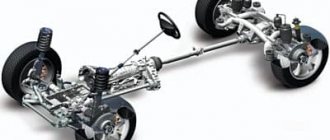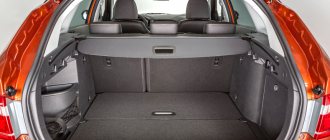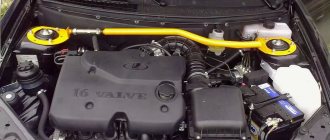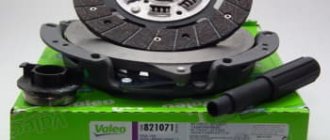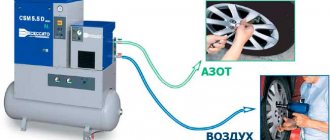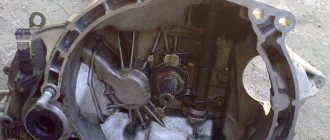Tuning is often a very expensive pleasure. As a rule, all trends come from the West, so in the arsenal of avid car enthusiasts there are many foreign words that are not known to the common man. So, for example, few people know what downpipes, dampers, and autobuffers are. The same situation repeats itself when we come across the concept of “coilovers”.
Coilovers are an adjustable shock absorber strut that allows you to change the stiffness of the shock absorbers and the ground clearance. Essentially, coilovers act as an adjustable suspension and consist of a support and a spring that wraps around its rod. Coilovers were first developed by Western professionals and used in sports and drifting competitions. The word consists of two parts - “coil” and “over”. If you translate each of them separately (the first is the spring, the second is around), then you can understand what coilovers are.
The main task of the device is to raise or lower the suspension. At the same time, it can be adjusted over a fairly wide range. Consequently, every day you can ride with completely new settings, because the product helps you easily change the ride height (clearance).
If you have a question about what adjustment range the screw suspension has, then the value is 8-10 cm when we are talking about A-arms. When we are dealing with a separate spring and shock absorber, the values vary and are 6-8 cm. However, there may be some variation within different models.
Coilovers (or struts) are an indispensable advantage on roads with poor surfaces or off-road.
What is a helical suspension?
Comfort and ease of control, stability and stability of the car are the main criteria for calm and safe driving on the roads. Today, automakers offer many solutions to ensure that all these criteria are met. One of them is the suspension. A car's suspension is a device that provides elasticity when driving over uneven surfaces. It is also capable of providing an elastic connection between the wheels and the body. The suspension is part of the chassis. Car suspensions use metal coil springs. The coils allow the spring to compress and decompress relative to the shock absorber. The shock absorber, in turn, can be made with adjustable stiffness.
For the fighting weekend
D2 Racing RS Series
These D2 RS coils have 36 compression force settings with separate preload adjustments. This will allow for more precise suspension tuning while maintaining the stance at all times during the race.
Eibach Multi-Pro-R2
Eibachs can help adjust angular weights for optimal balance. They also have a huge range of compression force adjustments, allowing you to optimize the car for comfortable or sporty driving.
Godspeed Project Mono-RS
Designed for the Nissan 240SX, Honda Civic, Subaru, Lexus and Mazda, these GodSpeed coilovers feature 32 firmness settings and a camber plates feature built into select models. A good choice for a weekend at the track on a tight budget.
H&R Premium
Like H&R's Street Performance, these coilovers will cost a pretty penny. This is primarily due to the use of lightweight materials in their construction to help reduce the weight of the vehicle.
HKS Hipermax MAX4GT 40th anniversary Limited-Edition
This is the best coilover option from HKS for street and track. They have 30 firmness settings, but they will be offered in limited quantities, so if you get your hands on one, congratulations.
Ksport GT Pro
Unlike standard coilovers, these Ksport GT Pros are special, using oversized 55mm inverted shocks for better performance. They are made to minimize the time the rod moves. They have 36 stiffness adjustments and also come with camber adjustment.
KW Clubsport
Created for serious guys who drive cars every day, but also don’t mind spending weekends on the track on normal skating rinks, ClubSports are one of the best for these purposes. They allow you to adjust suspension geometry, as well as adjust rebound and compression to fine-tune the entire suspension.
Teen Street Flex Damper
They are similar to Tein's Street Advance, except for more flexible flex settings and universal top mounts. This is a simple, ready-made solution for those who race on the street and around the ring.
Springs for coilovers
- Batteries Battery mount
- Battery terminals
- Ammunition and Safety Linen
- Cases and capes
- Radiator pipes 4X4
- TopCool
- High temperature lubricants and pastes - Exhaust system repair products
- Cabin filters
- Blow Off Adapters
- 76-100mm
- valves
- Stainless steel pipe for routes
- BMW
- Metal sleeve
- AEM – INNOVATE – SHLZ
- Original
- Bypass rollers, tension rollers, supports
- Nuts - Bolts - Max Guard Locks
- Lexus GS300 (disassembled)
- TUOSEN
- LED bulbs
- Windshield washer pumps
- Hoses for installation
- Sheets - Rods
- Land Rover
- Suspension components (repair) Honda
- Springs
- Spacers
- Spacers
- Springs
- Spacers
- Pads on the pedals
- Straight Violet
- Black
- Black
- Straight
- High voltage wires
- Fan controllers
- Adapters
- Rem. kits
- Sensors
- Turbines Actuators
- American AN10
- Tape
- Metal reinforced
- Car Alarm Keychains
What it is
UAZ on tracks
How to make coilovers with your own hands? To answer this question, it is advisable to understand the features of this device. In a nutshell, this is a stand with height adjustment. This is what the screw thread is for. Thanks to this, you do not have to cut the spring struts. The adjustment is made by unscrewing or tightening the coupling on the shock absorber. This allows you to lower the car without reducing the ride quality of the suspension. After all, the spring retains its length, the shock absorber is not clamped, and is able to perform its work completely as usual. Now let’s move on to the question of what this tuning gives, besides the low landing. The thing is that with proper regulation, the camber angle can be slightly corrected. This allows you to achieve higher performance on sports and drift cars.
Device. The basis for the coilover is a regular shock absorber strut. But only with sufficient rigidity, otherwise problems may arise when working in a “twisted” state. A threaded casing is used to control the rack. It can be initially threaded, or installed on top of the standard one. There is a spring between the upper platform and the control coupling.
What changes when installing coilovers?
In addition to the types of coilovers, there are two product series. Each of them is responsible for making its own individual changes:
- the Street series allows you to slightly increase the stiffness of the suspension. However, such modifications will also lead to the fact that the suspension will not roll when cornering, and will sway and dangle less. If you use the maximum adjustment of the presented coilover, the car’s handling will be closer to the sports class - you will notice how its behavior will change when changing lanes and turning.
- The Track series makes the suspension even stiffer and more composed, and the car more stable on the road. Using even the softest settings will give you a comfortable ride.
Coilovers for VAZ and other methods of lowering (video)
With the help of comfortable coilovers, you can significantly change the characteristics of the suspension that is installed on a particular car. But you should definitely take into account typical driving conditions. They work differently on different surfaces
That is why it is important to be extremely careful when using such elements in your car. The consequences of such applications must be fully understood. As you know, any modernization is only good in moderation
As you know, any modernization is only good in moderation.
Read also: How to choose the right hair straightener
In general, I decided to find an answer to my more than once asked question, what exactly are coilovers that many people around me talk about, here is the actual article explaining the essence of this question (Original article: Coilovers):
additional information
However, adjustable suspension has not only advantages, it also has disadvantages.
- Coilovers require careful maintenance and monitoring. In most cases, there are no seals on the rods to prevent dust and dirt from entering the body. And this leads to rapid wear of the bushings, which will result in knocking and jamming of the rod.
- Such a suspension must be adjusted for certain conditions, for example, driving on gravel or asphalt. If the coilovers are set to one surface, but you have to move differently, then this is fraught with shaking and the possibility of damage to the suspension. So, on asphalt it should work with short strokes, on gravel - with long strokes. If the suspension is not configured correctly, it will not follow the road profile, resulting in poor handling.
- Significant shaking when driving does not indicate that the suspension is working, but that it does not correspond to the driving conditions.
Coilovers allow you to change the characteristics of the existing suspension on your car. However, it must be designed for specific driving conditions and may not work equally well on different surfaces. So the use of such elements in a car must be treated with caution and the consequences of their use must be fully understood. » alt=»»>
Pros and cons of such shock absorbers
The main advantage of coilovers is the ability to change the ground clearance depending on road conditions. Moreover, adjustments can be made without much effort and at any convenient time. When using these struts, it is possible to adjust the suspension stiffness as accurately as possible, depending on your requirements. To lower the car, you do not need to cut the springs or engage in other barbaric actions. The main disadvantage is the need for synchronization during settings. If one pillar is even slightly higher than the other, the car will be very unstable on the road. At the same time, the level of safety when driving decreases. Often, after installing such racks, it is necessary to adjust the wheel alignment angles. Conclusion. Car tuning is developing more and more every year. At the same time, all directions strive to simplify design changes as much as possible. Due to the emergence of new modification methods, many people are wondering how to make their own coilovers. After all, thanks to such racks, you can lower the car efficiently, but at the same time not make irreversible changes to the design.
How much can you lower a car?
I know this question is now on the minds of many readers, rejoice guys:
The average lowering rate is from 20 to 35 mm, very good, now you don’t need to cut off the coils, you can lower your car simply by unscrewing the lower stop. In terms of ground clearance, this can give simply stunning figures. Fluctuations can range from 20 to 100 mm. Although when cutting springs, many achieve a lowering of 30 - 50 mm.
If your car is “pumped” and you need to perform at any shows, such as drifting or other sporting events. In just a couple of hours the car drops to the required ground clearance. After the show, it can be raised to a normal “sane” size and move around the city perfectly.
Flaws
Adjustable suspension requires proper maintenance and condition monitoring. The absence of seals on the rods leads to clogging of the shock absorber and its rapid failure. This is not the only weak point of coilovers.
Minuses:
- Tuning for specific road conditions eliminates a comfortable ride and good handling when switching to a different type of road surface.
- Unevenly adjusted suspension elements cause imbalance and reduced suspension performance.
- Adjusting the suspension requires professionalism and skill.
- After adjustment, it is necessary to adjust the wheel alignment.
- High cost of nodes.
- When installed on original racks, the reliability of the structure is reduced.
Difference from conventional racks
The classic strut used in cars has a simple design of a body and a spring. This is a very reliable option that has been used all over the world for a long time. However, it has a huge drawback - adjustment of this design is not provided. The spring has two attachment points; it is not possible to change one of them. The only option is to change the spring length, which is often done by beginners in the tuning field.
As for the coilover, it is fully adjustable. The lower stop moves freely along the thread, changing the position of the spring. Thanks to this, it is possible to adjust the height of the car without irreversible methods.
How to make coilovers with your own hands. Some secrets
If you wish, you can make coilovers yourself. If you don't want to spend money on new springs, you can simply purchase a kit that allows you to upgrade your old suspension. This is simply a casing equipped with threads. At the same time, your significant financial savings are obvious. You will also increase your own safety.
What types of coilovers are there?
Depending on the characteristics of the device, several types of products are distinguished:
- The most primitive ones consist of a shock absorber, the support of which is made on a threaded connection (instead of the traditional support for a spring). It is this design that allows you to adjust the ground clearance by moving the spring up and down. The main advantage is its low cost, the disadvantage is that the shock absorber stiffness cannot be adjusted.
- The second type has the ability to change the stiffness of the suspension. True, you will have to pay more for these adjustable stands than for the previous ones. For such a product, the stroke of the rod directly depends on the change in ground clearance. The main advantage is that coilovers can be installed on any car. There are quite a lot of disadvantages:
- deterioration in controllability;
- quick failure;
- frequent breakdowns.
- Full-tap coilovers, with which you can change three parameters at once: shock absorber stiffness, ground clearance and spring preload. Such devices are also known as “dgr coilovers”. Complete with the product you can often find support bearings that help adjust the camber angle of the wheels. The advantage is a range of suspension settings, which allows you to achieve the effects described above. The disadvantage is the high cost and complexity of installation.
All this is caused by the fact that the shock absorber wears out, because we leave both the ground clearance and the factory settings of the shock absorber.
- The last class is more advanced products. With their help, you can adjust low- and high-speed compression settings over even larger ranges.
In the photo: installed coilovers on the vehicle.
Advantages
The adjustable suspension is easy to install and offers selectable spring pre-compression for increased ride height.
In addition to the ease of adjustment with traditional tools, coilovers have a number of advantages:
- Ease of installation.
- Affordable prices.
- Possibility of adjusting ground clearance without removing the suspension.
- Correction of shock absorber stiffness.
- Versatility of design. This type of suspension is suitable for cars of any brand.
- Reliability and long service life.
- Select settings for hardness and wheel camber.
The degree of lowering depends on the type of coilover and the make of the car.
Most adjustable devices allow you to reduce the ground clearance by 20-50 mm.
DIY coilover
Since the price for such an upgrade is high, there is always the opportunity to make the necessary components. Although this task is quite difficult, it can be done with the necessary skills. This will allow you to save a significant amount and choose the part for your car.
Before starting work, you should select a shock absorber. It is necessary for the further functioning of the system, being its basis. It is recommended to purchase sports options, whose rigidity is much higher than that of classic ones. This will allow them to work in any position of the puck.
Advice! Using old racks for such work is ineffective. It is recommended to purchase new ones to ensure their lifespan is complete.
Next you need to sharpen the parts. A coilover requires two – a casing and a coupling. The role of the coupling will be played by a nut, complemented by a support washer. After fitting the parts according to the thread, you need to move on to the next stage - assembly. It is carried out as follows.
- The protective casing is removed from the standard rack.
- A previously machined workpiece is placed in place of the casing.
- The nuts are screwed onto the workpiece itself and the support washer is put on.
- The silent block and boot are installed.
Important! The previous silent block on the shock absorber may not be suitable. Therefore, it is worth determining the required diameter in advance according to the diagram. The last stage of creating such a design is installing the spring
The process is very problematic if there is no appropriate equipment. It can be found at your nearest auto repair shop, the task itself takes just a few minutes
The last stage of creating such a structure is installing the spring. The process is very problematic if there is no appropriate equipment. It can be found at your nearest auto repair shop, and the task itself takes just a few minutes.
As a result, the homemade coilover is ready, you just need to place it in the car
It is important to test its performance and maximum load so that this does not lead to a dangerous situation in the future. It is recommended to test it in different positions to determine the approximate load range
The process of creating coilovers is quite complicated, and the effort may not be worth the result achieved. Therefore, it is often easier and more reliable to purchase a finished product than to manufacture its components yourself.
And this video clearly shows the process of making nuts for coilovers. Although the blanks already have internal threads, applying them is quite simple. The video will help you understand the nuances of manufacturing such nuts, which are the main components that fix the spring in the required position:
- How to bleed brakes on a Priora without ABS and with ABS
- Why is the parking sensor beeping all the time?
- How to make and install a heated steering wheel with your own hands
- How to use a torque wrench
ADJUSTING VEHICLE CLEARANCE
The vehicle's ground clearance, in most cases, can be adjusted by the lower mount of the shock absorber strut (2) for some types of VP, the lower mount of the strut is not adjustable and the ground clearance can be set using the lower spring support (1).
For kits with adjustable bottom mount only:
- Lift the lower spring support (1) to press but not compress the spring.
- In some cases, the spring preload is left zero, BUT it is necessary to make sure that under the weight of the car the strut settles by 1/3 of the length of the shock absorber stroke (that is, the shock absorber works 1/3 in rebound and 2/3 in compression). If the car sags deeper than 1/3, then it is necessary to increase the spring preload until the above condition is achieved. Note: Do not attempt to use the lower spring support (1) to adjust the ride height.
- The vehicle's clearance must be adjusted by the lower support of the shock absorber strut (2). The clearance is adjusted by moving the lower support of the strut (2) along the thread, up or down. Tighten the lower spring support (1) and secure it with the lock nut (3)
It is recommended to use a torque tool to tighten the jack nuts (3, 4) with a tightening force of 70-80 N*M. If the locking nuts are not tightened well enough, extraneous noise may occur during movement and damage to the vehicle. To rotate the locking nuts, you must use a special wrench; it is included in the installation kit. If you are adjusting an already installed suspension, you must first thoroughly clean the threads of the strut to avoid damage.
For kits with separate spring and shock absorber arrangement:
For some car models in which the shock absorber and spring are installed separately, adjustment is made using an adjusting spring
Adjust the spring to the desired height, then lower the car to the ground and adjust the shock absorber (2) to such a length that, under load, the shock absorber rod (3) is 1/3 recessed into the shock absorber body, this is very important, since this condition will not be met , then the service life of the shock absorber will noticeably decrease
When the adjustment is complete, tighten all the locking nuts, install the wheels and ride for 5-10 minutes. Attention: The shock absorber must be screwed into the lower mount by at least 35 mm for McPherson suspension and 25 mm for multi-link!!! Attention: After installation and settings of the VP kit, it is necessary to check the boots on all struts, the boot should overlap the shock absorber body even in the upper position of the suspension - when the car wheels are hanging out
SHOCK ABSORBER LEAK
If you find oil leaks on the shock absorber, you need to show the car to a mechanic at a specialized center to determine the location of the leak. Remember that oil is applied to the surface of the shock absorber at the factory to prevent corrosion. As a rule, an oil leak from the shock absorber is accompanied by a knocking sound from the shock absorber. Diagnostics of the shock absorber:
- Step 1: Remove the shock absorber boot, then check for serious oil buildup on the shock absorber top cap.
- Step 2: Compress and decompress the shock absorber to its extreme points.
- Step 3: If the shock absorber rod moves jerkily during compression and rebound, the shock absorber must be replaced.
- Step 4: Make sure that the shock absorber has retained its full range of travel; if, under load, not the entire working surface of the rod is recessed into the shock absorber body, then the shock absorber must be replaced.
NOISE FROM SHOCK ABSORBER
- Check the tightness of all bolts and nuts.
- Check the upper spring mount and shock absorber mounts.
- Check for leaks from the shock absorber.
- https://automotolife.com/tuning/kojlovery-plyusy-i-minusy-reguliruemoj-podveski
- https://d2racing.ru/instructions/d2-suspension-setup-with-adjustable-stiffness
- https://www.syl.ru/article/371504/vintovyie-podveski-vidyi-ustanovka-i-regulirovka
- https://opalubka-expert.ru/vintovye-stojki-dlya-opalubki/
- https://podveska-avtomobilya.ru/kojlovery-ili-kak-ix-eshhe-nazyvayut-vintovaya-podveska-avtomobilya.html
- https://fb.ru/article/269118/vintovyie-podveski-osobennosti-ustanovka-nastroyka
- https://znanieavto.ru/hodovaya/kojlovery-ili-vintovaya-podveska.html
Popular manufacturers
Coilovers from a reliable manufacturer pay for themselves due to their long service life.
Adjustable screw suspensions are produced by reliable companies:
- (Sweden).
- (Britannia).
- Concern "Kayaba" (Japan).
- Enterprise "H&R" (Germany).
- (Germany).
- (Netherlands).
- (Belgium).
- XYZ Racing (Taiwan).
- Guangzhou Fat Chassis Technology Company (China).
This is interesting: NOKIAN tires
British is the world's most famous manufacturer of screw systems equipment. The company produces four types of coilovers for different purposes.
Types of coilovers
At the moment, there are all two main types:
- Allows you to mount a threaded enclosure onto your stock rack, making it essentially a must-have upgrade kit. The downside of such a system is that the standard rack may not be able to cope with the increased load on it and will quickly fail. Also, if the compression is too strong, it practically stops working altogether, which affects the handling of the car.
- This is a ready-made coilover assembly - we just remove the old struts and install new ones. The advantage here is that the rack is already designed for different load conditions, its service life is much longer.
Kinds
There are several types of screw pendants. The first type includes coilovers, which replace only the spring. Such kits look like this:
Usually these screw suspensions are used in the rear. These coilovers are cheaper and easier to install. But they have one serious pitfall. So, after installing this spring, the shock absorber remains standard. Accordingly, its strokes will be limited, and the rod will not cope with the work of the suspension. This may result in poor maneuverability.
A more correct option is to install coilovers along with shock absorbers. These mechanisms are usually installed on the front of the car, instead of the factory struts. Thus, the coilover completely replaces the standard spring and shock absorber. Among the advantages, reviews note good handling and greater opportunities for lowering the car. Standard shock absorbers use high bump stops. And when hitting a bump, the suspension will suffer serious blows.
Advantages of coilover suspension
- These suspension elements are designed taking into account various workloads and are therefore made from high quality materials.
- Inexpensive coilovers for adjusting suspension stiffness and ground clearance do not require special skills or equipment for installation.
- The car's suspension can be quickly adjusted literally before every trip.
- It is possible to retrofit existing racks, and, if necessary, switch back to a standard suspension.
- When used carefully, coilovers retain their performance characteristics for a long time and do not break.
Disadvantages of adjustable shock absorbers
- To guarantee quality and performance, it is necessary to buy models from trusted manufacturers. And the cost of even moderately functional products in this case is comparable to high-quality analogues for a standard suspension.
- When adjusting coilovers, it is often necessary to additionally work with the wheel alignment.
- Adjusting the suspension can negatively affect maneuverability, handling, and behavior on uneven, wet or slippery roads. All this additionally affects fuel consumption and wear of other components and parts of the car.
- When installed on standard suspension struts, the latter wear out quickly.
Thus, with reasonable installation and thoughtful tuning, coilover suspension makes driving more comfortable, easier and more confident, and also allows you to give it the necessary sporty look. The main thing is to choose the right part for installation, not to skimp on quality and to ensure that its operation does not actually deteriorate the driving performance of the car.
Coilovers vs Normal shocks. Or coilovers versus conventional shock absorbers.
Today, using the example of the AST 4100 and 5100 suspension kits for the BMW e90, we will examine one topic and dispel a couple of myths that haunt tuners - Coilovers or Not - what to take! First, let's define the terminology. Many people confuse the concepts of coilovers (from the English Coilover, which means a spring on a shock absorber, and is suitable for all MacPheron-type shock absorbers) and screws (shock absorbers with screw adjustment of spring preload or spring installation height.) So, coilovers will be both, but screws (but we are much closer and clearer to shock absorbers with height adjustment) will only be those that have a thread on the strut body or on a special spring preload adjuster, if they are separate from the shock absorbers. Let's look at the pictures:
But why do colas (coilovers) excite the blood of tuners so much? Simply because this formulation comes from sports, where function is more important than design, cost and many other things. We are talking about the rear shock absorbers, which are being converted into a coilover version in order to simplify the work of selecting springs and optimize the team’s inventory. In this case, linear racing springs are used, which are usually standardized in three parameters - internal diameter, length and stiffness, and can be applied to any front and rear shock absorber, any type of shock absorber, for any car. This is the trick, gentlemen! Do not confuse warm with soft, they are not the same thing! Let's look at the pictures:
Our page on DRIVE2:
Comments 35
Maybe someone can tell me about preload, I installed XYZ coilovers on an Audi A5, not ast of course, but still) There is no one in Lipetsk who understands adjustable suspensions. the craftsmen said that they could do everything, but in the end they installed it within two days) Everything seemed to work out, but when I picked up the car, it turned out that it had become somehow too springy, the rear was throwing up on speed bumps even at low speed so that everything in the trunk flew up . The question is, why does this happen, is it the peculiarities of this suspension and nothing can be done, or did they do something tricky with the tightening of the springs? According to the instructions, no preload should be done. At the rear, the shock absorber and spring are separated. According to the manufacturer of the spring 10 kg
If there is a rebound adjustment, it needs to be closed, now the rebound is too soft. In general, these are the features of XYZ type suspensions and the like. None of these manufacturers work on the quality of settings and their product as a whole.
Thank you, there is only a hardness adjustment, i.e. If I understand correctly, there is compression, but no rebound adjustment.
And if you preload the springs, will this somehow change the situation?
Preload will not change the situation. If you have one adjustment, it is rebound adjustment, in extreme cases combined with compression. Spin it.
OK, thank you very much!
PS But the biggest problem is that on the Audi S5 the cups are closed, it’s impossible to get to the knobs))) Before this, I didn’t have such problems on the Alphas, I didn’t even think about it before buying the kit. The craftsmen, of course, are also handsome, they said after installation)) There was no support from XYZ, six days later they answered briefly that the front can be adjusted with some kind of cable extensions, while drilling a hole in the cup, but the rear ones cannot be...)))
Maybe you have some universal accessories to solve such issues?
We have a solution - replacing it with a normal suspension: Bottom twisters: www.drive2.ru/o/b/1134129
I'll keep that in mind, unfortunately it's not in my budget yet.
And suspension is never “on budget.” Here you need to make a strong-willed decision and take it. Take a good one right away. All intermediate options will suck up many times more money. My grandmother once said: “There is nothing more durable than “temporary.”
It's simple. Springs come in different lengths, for example I have 8kg/mm with a length of 250 and 300mm. Both of them can be placed on the same rack, but the position of the lower cup will be different, while the static position of the body will remain the same.
Alexey, can you expand a little on the issue of spring preload? What's the point? As far as I remember, Eibach (probably other spring manufacturers) standardize stiffness starting from a certain compression stroke of the spring (something like 20mm, if memory serves). Perhaps this is due to the fact that in the initial section the characteristic of the spring is nonlinear and it is easier to bypass it by initially loading the spring with preload and bringing the characteristics to a linear section, rather than taking it into account and normalizing it?
This is a conventional term. There is a concept of the static position of the car and it is set by these nuts or adjustable supports. The spring is compressed exactly as much as the body weight acts. For example, you have a rear axle with a static load of 320 kg, 160 kg per wheel. There are springs with a stiffness of 4 kg/mm. So their body will shrink by a little more than 4 cm.
I don’t completely agree with you, but I don’t want to argue. Let's wait for Alexey's answer.
Alexey also wrote articles on basic suspension tuning many years ago, and that’s there too. If I clarify that 4 cm is what was clamped with the nut. Do you agree with everything?
Let's just say I completely agree about the static position at a given spring stiffness and wheel load, this is obvious. But I only partly agree about the precise adjustment of ground clearance “with these nuts”. I’ll try to explain: it is assumed that in the static position of the car the shock absorber is in the middle of its stroke, let’s call this the “zero position of the suspension height.” In this situation, Alexey recommended limiting the adjustment range to 20-30mm on both sides of “zero” using “those same nuts”; the rest (if necessary) is regulated by changing the length of the rack body. For this, threaded support glasses with their own locknuts are usually used. This is where the root of my doubts is buried - if the height is adjusted correctly without rearranging the spring support plate in height with “the same nuts”, but by adjusting the length of the entire shock absorber strut itself, then why then in a number of designs do we see both lock nuts and nuts? And where did the term “preload” even come from?
You mention two different types of shock absorbers. One with an adjustable body, where the preload is not adjusted, and to adjust the ground clearance, an adjustment is used on the glass by screwing or unscrewing the shock absorber together with the spring from the body. Typically, such designs are used for asphalt suspensions, where there is little travel, and adjusting the spring preload will lead to a shortage of compression or rebound travel. For example, the total stroke is only 80 mm, 40 each for compression and rebound. By shifting the balance by 10 mm, we will get a dubious result in one of the directions of shock absorber operation. Here it is easier to change the ground clearance by moving the shock absorber out of the body. Yes, it’s cheaper - you make identical cartridges and screw them into different housings. This is usually done by manufacturers from Taiwan, Japan and China. But this does not give the maximum possible result. But when there is enough travel, and it is possible to move 15-20 mm in both directions, then they work with preload. In general, the characteristic of a spring is linear if the spring itself is linear. So it will compress equally in any range.
Alexey, can you expand a little on the issue of spring preload? What's the point? As far as I remember, Eibach (probably other spring manufacturers) standardize stiffness starting from a certain compression stroke of the spring (something like 20mm, if memory serves). Perhaps this is due to the fact that in the initial section the characteristic of the spring is nonlinear and it is easier to bypass it by initially loading the spring with preload and bringing the characteristics to a linear section, rather than taking it into account and normalizing it?
Here's the thing. In sports springs, the top and bottom usually have trimmed and pre-tensioned coils so that they immediately sit flat on the supports and nuts. technologically, in such springs there will always be a gap between the edge of the coil and its neighbor. therefore, when measuring stiffness from scratch, there will initially be a lack of stiffness until the gap closes. Usually about 10mm is enough to close the gap. preload in the suspension has other purposes and is usually not associated with this effect. In some ideal, we should strive for zero preload, but this is not always possible based on weight distribution, required stiffness and kinematics limitations.
Source
Pros and cons of coilovers (coil suspension)
Like any other element, coilovers have their pros and cons.
The advantages of coilovers include:
- simplicity of design, its simple and quick installation;
- the ability to raise and lower the car (adjust ground clearance) without interfering with the suspension;
- optimal cost, because there is no need to perform expensive suspension tuning;
- versatility - installation can be carried out on any car model;
- the ability to change the stiffness of shock absorbers, as well as install them in standard places.
Disadvantages of a screw suspension:
- the price of coilovers exceeds the price of even the highest quality shock absorbers;
- sometimes it is not possible to install on existing racks;
- adjusting the coilovers leads to the need to adjust the wheel alignment;
- If you change the settings, the car may become unstable and its performance may significantly decrease.
Having familiarized yourself with what “coilovers” are, it becomes clear that this is simply a shock absorber, which is additionally equipped with a spring. The latter makes it possible to adjust various parameters, such as rigidity and vehicle clearance. We hope that it will now become clear whether your car needs the installation of such a device.
Carrying out setup
Once you have installed the new suspension, you can begin tuning and adjusting. Everything is done using screws. Most types of coil suspensions have the ability to adjust spring preload, caster, ground clearance and camber.
For different options, the number of configurable parameters also varies. In some suspension versions, simultaneous adjustment of spring preload and ground clearance will be available. This makes it possible to change the height of the car above the road and the stiffness of the suspension.
But such models do not have individual settings for related parameters. The top models have at their disposal up to a couple of dozen possible rigidity positions and settings of other parameters. These include both compression and castor with rebound, and the adjustment is made individually, and not in the coupe.
Using a stand or machine, you can adjust the first parameter in case of a remote spring installation (spring with locknut).
At the bottom of the strut, you can adjust the ride height using two nuts. You will change it by loosening the locknut without changing the stiffness of the shock absorbers, and to make adjustments to the castor with camber, tighten the bearing together with the spring cup.
Vehicles of legal entities and individual entrepreneurs are registered at the place of state registration of these legal entities and individual entrepreneurs. It is allowed to register vehicles of legal entities at the location of their branches, representative offices and other separate divisions.
Read more…
Features of registration of purchase and sale of a car
Transferring ownership of a vehicle involves completing some bureaucratic procedures and complying with a number of formalities. Read more…
Sold a second car - pay taxes
Many car enthusiasts do not even suspect that after selling two or more cars during the year, they are required to file a declaration with the tax office. At the same time, if you sell the second car for more than you bought it, you are required to pay tax on the sale amount. Read more.
. .
How to sell a car without deregistration
How to sell a road vehicle without deregistration? The solution to this problem worries many car owners. Read more.
. .
Contract for the sale and purchase of a car from a legal entity to an individual
At the moment, not only individuals, but also companies use the services of the car sales market, as they need to regularly update their working cars. Read more…
How to correctly draw up a car purchase and sale agreement
When selling a car, it is very important to legally formalize the purchase and sale agreement. Current legislation regulates certain rules for conducting a transaction, taking into account the interests of both the seller and the buyer
Read more.
. .
How to avoid a fine for car tinting
If you like to tint your car all around, then this text is just for you. How can you avoid getting fined for something like this?
Read more…
How to check a car's history by VIN code
One of the most important indicators by which you can determine the most significant information regarding a car is its VIN number. Using this code, you can determine in which country and when the car was produced, its main technical indicators and even its history (owners, whether it was pawned or stolen).
Read more…
